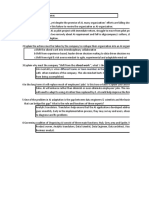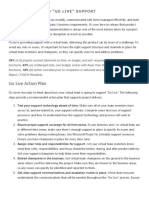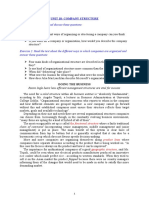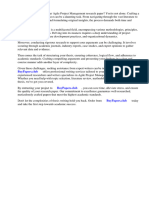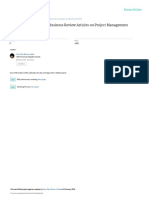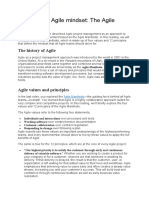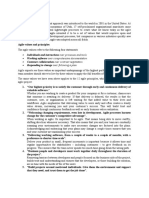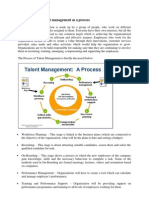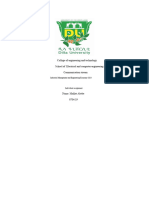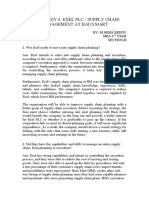Case Study 3: 75% of Cross Functional Teams Are Dysfunctional
Case Study 3: 75% of Cross Functional Teams Are Dysfunctional
Uploaded by
neha reddyCopyright:
Available Formats
Case Study 3: 75% of Cross Functional Teams Are Dysfunctional
Case Study 3: 75% of Cross Functional Teams Are Dysfunctional
Uploaded by
neha reddyOriginal Title
Copyright
Available Formats
Share this document
Did you find this document useful?
Is this content inappropriate?
Copyright:
Available Formats
Case Study 3: 75% of Cross Functional Teams Are Dysfunctional
Case Study 3: 75% of Cross Functional Teams Are Dysfunctional
Uploaded by
neha reddyCopyright:
Available Formats
CASE STUDY 3: 75% OF CROSS FUNCTIONAL
TEAMS ARE DYSFUNCTIONAL
BY: M NEHA REDDY
MBA 1ST YEAR
SECTION-B
CROSS FUNCTIONAL TEAMS: Cross functional teams are
groups consisting of people from different functional areas of
the company – for example, marketing, product, sales, and
customer success.
Cross functional groups fail often because of lack in systematic
approach in organization. Unclear governance, lack of
accountability and failure of organization to prioritize the
success of cross functional projects hurt the teams.
1. Do you believe that Cisco can continue on cross functional efforts or it
was one time effort?
To improve router security, Cisco formed a cross-functional team that
included officials from marketing, software engineering, manufacturing,
quality assurance, and customer service. The team was organized into
three layers. The sessions could accommodate up to 100 individuals, but
there was a core group of 20 who communicated back to their respective
functions. A tiny governance team, consisting of two vice presidents, the
company's chief development officer, and the leader of the core team of
20 individuals, sat at the top.
This cross-functional governance initiative was successful. Cisco is now
the most popular router security vendor, with sales increasing by roughly
80%.
Yes, I believe that Cisco can continue on cross functional efforts as it
successfully formed a cross functional team and got the satisfied results
from it through a good leadership.
2. Do you think that the guidelines provided in the case study will make
cross functional teams more effective. Justify your answer?
Guidelines provided in the case study are
Every project should have an end-to-end accountable leader.
Every project should have clearly established goals, resources, and
deadlines.
Teams should have the project’s success as their main objective.
Every project should be constantly re-evaluated.
Cross-functional teams in large firms with multi-layered hierarchies can
benefit from a mirroring structure. Each function should be overseen by
one end-to-end accountable leader, with one end-to-end accountable
leader supervising everything.The personal accountable leader for each
function also needs to appoint and empower a decision-making substitute
as one of the common breakdowns in cross-functional teams is people
missing meetings.
There should be a budget that has been approved, as well as a charter that
outlines priorities, desired goals, and timelines.
Different functions may have their own priorities, which may conflict
with the project's objectives. That's why it's critical to factor in the
success — or failure — of cross-functional projects in the compensation
and performance evaluations of team members and leaders.
Product Growth Teams(PGT) should retain a list of projects and priorities
and cut those that aren't working or don't correspond with company
objectives on a regular basis. A PGT that does not terminate some
projects on a regular basis is simply not performing its job.
Yes, I think that the guidelines provided in the case study will make cross
functional teams more effective.
3. Give me another example of different company where cross functional
teams have been successful in executing a critical project. Explain what
the project is and how it is executed?
Apple abandons the traditional authoritarian leadership paradigm in
favour of allowing each team member to promote ideas, debate
perspectives, and finally build on each other's thinking to arrive at the
optimal answer.
Even in ways that consumers may not notice, Apple is all about the user
experience. As finished items move through their supply chain and sales
channels, this crew is in charge of keeping things running smoothly. They
collaborate with other Apple teams to find ways to improve operations,
such as making it easier for customers to order products online and pick
them up in store.
The innovative iPhone was created by a cross-functional team at Apple.
They gathered experts from several areas across the company to kick off
what would become the smartphone revolution. They are regarded as one
of the best teams in history for their contributions to innovation.
It is currently known around the world for its hardware, software, and
service breakthroughs. Apple has grown from 8,000 people and $7 billion
in revenue in 1997, when Steve Jobs returned, to about 240,000
employees and approximately $275 billion in revenue by 2020. Apple's
huge success is largely due to its organizational culture, which
encourages cross-functional collaboration, and the leadership paradigm
that goes with it.
You might also like
- PP 2021 Icas en Eng D CDocument46 pagesPP 2021 Icas en Eng D CChu Steven100% (1)
- Project A: Development and Collaboration Software Company - AtlassianDocument10 pagesProject A: Development and Collaboration Software Company - AtlassianFeizhen Mae80% (5)
- Top 101 Consulting FrameworkDocument205 pagesTop 101 Consulting FrameworkWilmer Chacón88% (8)
- Case Study 1: The Inexorable Rise of WALMART 1988-2016Document2 pagesCase Study 1: The Inexorable Rise of WALMART 1988-2016neha reddyNo ratings yet
- Learning and DevelopmentDocument17 pagesLearning and Developmentvanshika sharmaNo ratings yet
- Agile For Instructional Designers by Megan TorrenceDocument55 pagesAgile For Instructional Designers by Megan Torrencevictorperez3567% (3)
- Case Study 4: Mcdonald India:Optimizing The French Fries Supply ChainDocument3 pagesCase Study 4: Mcdonald India:Optimizing The French Fries Supply Chainneha reddyNo ratings yet
- Safe QuestionsDocument4 pagesSafe QuestionsFernando CruzNo ratings yet
- Dear Evan Hansen Movie ScriptDocument138 pagesDear Evan Hansen Movie ScriptBudigoy Ibarra100% (3)
- HBR Test 1 - AnswerDocument4 pagesHBR Test 1 - AnswerJimy WalesNo ratings yet
- Emre - Week 12Document4 pagesEmre - Week 12Emre UzunogluNo ratings yet
- 41 QuestionsDocument4 pages41 QuestionsjramkiNo ratings yet
- Go Live Action PlanDocument19 pagesGo Live Action Plannico597No ratings yet
- Method To Madness FinalDocument11 pagesMethod To Madness FinalVijayNo ratings yet
- Distributed Agile Testing EbookDocument29 pagesDistributed Agile Testing EbooknericssoNo ratings yet
- Exercise 1. Before You Read Discuss These Questions:: Unit 10: Company StructureDocument24 pagesExercise 1. Before You Read Discuss These Questions:: Unit 10: Company StructureDaniela DanilovNo ratings yet
- Agile Project Management Research PaperDocument5 pagesAgile Project Management Research Paperafmdaludb100% (1)
- HRM 2022 Ch03Document48 pagesHRM 2022 Ch03Nivi MiNo ratings yet
- Principles of Management Chap 5-8Document9 pagesPrinciples of Management Chap 5-8Andrea OlescoNo ratings yet
- Agile Kaizen - Group Assignment 1Document5 pagesAgile Kaizen - Group Assignment 1Christian LlerenaNo ratings yet
- Agile OrganizationDocument5 pagesAgile OrganizationMarwan RagabNo ratings yet
- Case Analysis New 2022-23Document83 pagesCase Analysis New 2022-23prabhu cNo ratings yet
- Assignment Assessment 3 - Individual Essay - Pham Duc Long-1Document8 pagesAssignment Assessment 3 - Individual Essay - Pham Duc Long-1Long Pham DucNo ratings yet
- Consulting: Developing LeadersDocument13 pagesConsulting: Developing Leaderslittlehearts143No ratings yet
- 3 Summaries of Harvard Business Review Articles On Project ManagementDocument9 pages3 Summaries of Harvard Business Review Articles On Project Managementshiphatun noorNo ratings yet
- Software House Practices 3498Document11 pagesSoftware House Practices 3498sįleňT HĕąrťNo ratings yet
- Business Case About Agile Transformation @me PDFDocument4 pagesBusiness Case About Agile Transformation @me PDFSara Lucia CárdenasNo ratings yet
- IBM Global Human Capital StudyDocument72 pagesIBM Global Human Capital Studypraneeth.patlola100% (9)
- Business Transformation: A Considerable Challenge For The CHRO and CIODocument10 pagesBusiness Transformation: A Considerable Challenge For The CHRO and CIOImmanuel Giulea100% (1)
- List and Explain The Traits If A Professional ManagerDocument10 pagesList and Explain The Traits If A Professional ManagerAmitabh ChatterjeeNo ratings yet
- The Agile ManifestoDocument3 pagesThe Agile ManifestoMuhammad SaadNo ratings yet
- Innovation ManagementDocument13 pagesInnovation ManagementAdreena4696No ratings yet
- Notes On PMTDocument2 pagesNotes On PMTEmmanuel EzenwaNo ratings yet
- A Transformation of The Learning Function Why It Should Learn New WaysDocument6 pagesA Transformation of The Learning Function Why It Should Learn New WaysFamiglia RedNo ratings yet
- Ricardo Mamahit - Strategic Management MIDDocument5 pagesRicardo Mamahit - Strategic Management MIDKim FoxNo ratings yet
- T & D, APEX SolsDocument94 pagesT & D, APEX SolsVasu GongadaNo ratings yet
- Course 5Document41 pagesCourse 5tNo ratings yet
- 3.5 Emerging Faster and Stronger - Building Blocks of The "New Normal" Operating Model McKinsey & CompanyDocument6 pages3.5 Emerging Faster and Stronger - Building Blocks of The "New Normal" Operating Model McKinsey & CompanyJohn Gilbert GopezNo ratings yet
- Business Analysis: The Evolution of A Profession: by Kathleen Barret, IIBA President and CEODocument4 pagesBusiness Analysis: The Evolution of A Profession: by Kathleen Barret, IIBA President and CEOLuisNo ratings yet
- Organizational BehaviourDocument18 pagesOrganizational BehaviourPrasoon ShrivastavaNo ratings yet
- SAFe Agilist 5Document421 pagesSAFe Agilist 5dragososiceanuNo ratings yet
- Project Management - MB0049: Q.1 List and Explain The Traits If A Professional ManagerDocument5 pagesProject Management - MB0049: Q.1 List and Explain The Traits If A Professional ManagergurugabruNo ratings yet
- 6 AlishaChhabra MOTDocument21 pages6 AlishaChhabra MOTAlisha ChhabraNo ratings yet
- Frede Lee E. FloresDocument4 pagesFrede Lee E. FloresJovito Dela TorreNo ratings yet
- From Product Manager To Product Leader by ProductPlanDocument100 pagesFrom Product Manager To Product Leader by ProductPlankonekote100% (2)
- Core Competency Doc.2Document4 pagesCore Competency Doc.2aamirrazzaqNo ratings yet
- Importance of Talent Management TodayDocument9 pagesImportance of Talent Management TodayAshutosh GoelNo ratings yet
- The Other Side of Innovation (Review and Analysis of Govindarajan and Trimble's Book)From EverandThe Other Side of Innovation (Review and Analysis of Govindarajan and Trimble's Book)No ratings yet
- HRM For Online ClassDocument39 pagesHRM For Online ClassPRATIK MUKHERJEENo ratings yet
- Mba Dissertation On Training and DevelopmentDocument5 pagesMba Dissertation On Training and DevelopmentIWillPayYouToWriteMyPaperUK100% (1)
- 5 L&D Challenges in 2024Document7 pages5 L&D Challenges in 2024vishuNo ratings yet
- Agile Org Guide enDocument88 pagesAgile Org Guide enJorge Paulo de LimaNo ratings yet
- Best Practices - The Nine Elements To SuccessDocument11 pagesBest Practices - The Nine Elements To SuccessDieudonné AllaramadjiNo ratings yet
- Marta AssDocument15 pagesMarta AssERMIAS AmanuelNo ratings yet
- Types of TeamsDocument16 pagesTypes of Teamskakkarsunil100% (1)
- Innovation Assignment3Document17 pagesInnovation Assignment3Adzrul ShahkizNo ratings yet
- Bovee CH02Document24 pagesBovee CH02Malik WajihaNo ratings yet
- Lean in Six StepsDocument5 pagesLean in Six StepsMohamed Farag Mostafa100% (1)
- Lec 35Document21 pagesLec 35jrntrmprNo ratings yet
- Agile: Axel Christian Santos BloomfieldDocument17 pagesAgile: Axel Christian Santos BloomfieldAxel Christian Santos BloomfieldNo ratings yet
- AgileDocument8 pagesAgileElias TomNo ratings yet
- IT GOVERNANCE APPROACHES FOR AGILE SOFTWARE DEVELOPMENT INVESTMENTSFrom EverandIT GOVERNANCE APPROACHES FOR AGILE SOFTWARE DEVELOPMENT INVESTMENTSRating: 4 out of 5 stars4/5 (1)
- Case Study 6: Exel PLC - Supply Chain Management at Haus MartDocument2 pagesCase Study 6: Exel PLC - Supply Chain Management at Haus Martneha reddyNo ratings yet
- Case Study 5: Iphones Supply Chain Under ThreatDocument3 pagesCase Study 5: Iphones Supply Chain Under Threatneha reddyNo ratings yet
- Case Study 2: Sustainability of Ikea GroupDocument3 pagesCase Study 2: Sustainability of Ikea Groupneha reddyNo ratings yet
- Case Study 3: Starbucks Corporation: Building A Sustainable Supply ChainDocument5 pagesCase Study 3: Starbucks Corporation: Building A Sustainable Supply Chainneha reddyNo ratings yet
- Bahasa Inggris Kelas 2Document3 pagesBahasa Inggris Kelas 2tutyNo ratings yet
- The Age of Surveillance Capitalism TextDocument7 pagesThe Age of Surveillance Capitalism TextwadnermanNo ratings yet
- 10 1 1 623 275 PDFDocument28 pages10 1 1 623 275 PDFDamir MiletaNo ratings yet
- DLL Pe q2 WK 1 BasketballDocument3 pagesDLL Pe q2 WK 1 BasketballRuth AramburoNo ratings yet
- Department of Education: I. Encircle The Letter of The Correct AnswerDocument2 pagesDepartment of Education: I. Encircle The Letter of The Correct AnswerJhonabie Suligan Cadeliña100% (2)
- Mayo V SatanDocument2 pagesMayo V SatanRix MigriñoNo ratings yet
- Analytical Chemistry Experiment 4Document6 pagesAnalytical Chemistry Experiment 4Ngoh KexuanNo ratings yet
- Birla Institute of Technology and Science, Pilani Pilani Campus AUGS/ AGSR DivisionDocument4 pagesBirla Institute of Technology and Science, Pilani Pilani Campus AUGS/ AGSR DivisionPriyam VermaNo ratings yet
- CV English VersionDocument5 pagesCV English Versionapi-3748656100% (2)
- Allen Ginsberg ThesisDocument7 pagesAllen Ginsberg ThesisPaperWritersCollegeCanada100% (1)
- Business EtiquetteDocument16 pagesBusiness EtiquetteshivangiNo ratings yet
- MODULE 1 - An Introduction To Culture and PsychologyDocument7 pagesMODULE 1 - An Introduction To Culture and Psychology21-60448No ratings yet
- Georg Heym's Der Dieh - Ein Novellenbuch. Five Short Stories in en PDFDocument166 pagesGeorg Heym's Der Dieh - Ein Novellenbuch. Five Short Stories in en PDFMirek BodnarNo ratings yet
- Economics Practice ExamDocument33 pagesEconomics Practice ExamMelissa Douglas100% (1)
- Discrete Mathematics and Its Application - Chapter 9Document70 pagesDiscrete Mathematics and Its Application - Chapter 9Funkey dunkey100% (1)
- My Father Went To SwitzerlandDocument11 pagesMy Father Went To SwitzerlandDragoș StanNo ratings yet
- Mba Cbcs Oct Nov 2014Document6 pagesMba Cbcs Oct Nov 2014Avinash KanaseNo ratings yet
- Assignment 5Document10 pagesAssignment 5Joseph PerezNo ratings yet
- Marketing Strategy Starbucks IndiaDocument5 pagesMarketing Strategy Starbucks IndiaMohammad Imad Shahid Khan100% (1)
- 12082023-Niger CoupDocument2 pages12082023-Niger Coupakulasowjanya574No ratings yet
- Trail of BloodDocument5 pagesTrail of BloodGeorge VladuNo ratings yet
- How To Write A Book Report. EnglishDocument2 pagesHow To Write A Book Report. EnglishKit Anton MacalosNo ratings yet
- EMA Report For Nov, 2023Document7 pagesEMA Report For Nov, 2023owaismsNo ratings yet
- BMC Women's Health: Eating DisordersDocument6 pagesBMC Women's Health: Eating DisorderslinhamarquesNo ratings yet
- What Is OrgasmDocument5 pagesWhat Is OrgasmTD AlexaNo ratings yet
- Content and Pedagogy PPT 221002124246 61e1cc30Document37 pagesContent and Pedagogy PPT 221002124246 61e1cc30Gladys GaleraNo ratings yet
- Schenectady County Polling SitesDocument1 pageSchenectady County Polling SitesAndrew PuglieseNo ratings yet
- A Psalm of Life by Henry Wadsworth LangfellowDocument2 pagesA Psalm of Life by Henry Wadsworth LangfellowVirgilio FeliciaNo ratings yet









